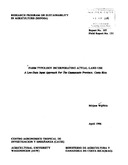| dc.description.abstract | The USTED methodology is a linear programming model, which supports land use planning as regional planning of agricultural lands. Although it is focused at the regional level, it does include the farm level as well and it will mainly concentrate on the definition of farm types. These farm types are generalizations of the relatively large number of farms in the study area and are determined by farm size and soil type. Actual land use can not be used for the determination of these farm types, because the output of the methodology comprises land use. Still it might be important to relate farm sizes and soil types to actual land use, so that decisions of farmers are also included in the methodology. So this thesis tries to define farm size classes, related to actual land use, in order to determine farm types for the farm typology to be used for the USTED methodology. To get an overview of actual land use in relation to farm size and soil types, an inventory is carried out for a limited number of farms, on the basis of interviews. The investigated area is a part of the Guanacaste province, which is situated in the nort-west of Costa Rica. In the farm typology all the farms which are grouped together in farm types are included. Due to the impossibility to incorporate all the farms of the study area, a stratified sampling is used to define farm size classes. To get a sample of farms with the greatest pilot areas are chosen, where interviews are held. To see if this sample is a representative sample of the study area, two distributions are compared, one from census and one from interviews. When it seems to be a representative sample, data from interviews can be used to obtain the following information: - Types of soils and variances in soils within one farm. - Relation between farm size and current land use. - Relation between soil type and current land use. - Relation between parcel sizes and farm sizes. - In case of cattle breeding details can be mentioned about different pasture systems in relation with farm sizes. To make farm size classes, seven soil clusters from the study area, are distinguished, which are associations of soil types between different soil groups or combinations within one soil group. Soil group characteristics, which determine land properties, are given together with land use requirements of the occurring crops and pasture types, in order to get information about soil suitabilities which finally can be used for a land evaluation. This land evaluation is used to compare the expected land use with actual land use. Beside using scientific names of soil types it also seems important to use local names (the way farmers call them), because the relation between soil type with local names and land use seems more clear than the relation with scientific names. When looking at the relation between farm size and current land use, six land use classes are distinguished: homegardens, crops, pasture, forest, tree plantation and fallow. When farm size classes were related with actual land use there was a relation, but because these farm size classes are arbitrarily chosen, they did not coincide with actual land use. To rectify this fault, individual farms, instead of farm classes, were plotted per different soil cluster. Looking at the relation between soil type and current land use. Homegardens, forest and fallow occur on mostly all soil clusters, crops on fertile soils, and tree plantation is mainly present on soils with steep slopes. Pasture occurs on all soil clusters and is often the main land use cover. Because pasture is very important in the study area, differences are made as well in pasture systems, like pasture without animals, beef cattle, breeding cattle, dairy cattle and double purpose are investigated. It could be concluded that pasture systems were related to agro-ecological zones, which means that theses systems are more or less related to soil types. A relation between parcel size and farm size could not be made. So each farmer determines his land use by the occurring soil types. For the farm typology it is recommendable to define farm size classes per soil type, for each soil type has its own land use. In this way farm size classes coincide with actual land use and farm types may be better classified than in the past. | es_ES |


